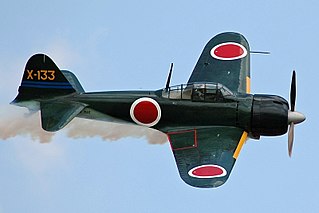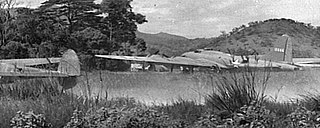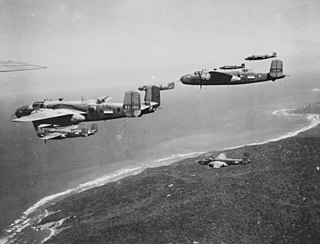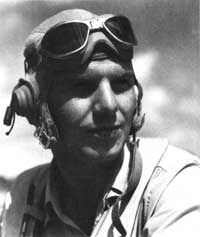Related Research Articles

The Curtiss P-40 Warhawk is an American single-engined, single-seat, all-metal fighter-bomber that first flew in 1938. The P-40 design was a modification of the previous Curtiss P-36 Hawk which reduced development time and enabled a rapid entry into production and operational service. The Warhawk was used by most Allied powers during World War II, and remained in frontline service until the end of the war. It was the third most-produced American fighter of World War II, after the North American P-51 Mustang and Republic P-47 Thunderbolt; by November 1944, when production of the P-40 ceased, 13,738 had been built, all at Curtiss-Wright Corporation's main production facilities in Buffalo, New York.

The Mitsubishi A6M "Zero" is a long-range carrier-based fighter aircraft formerly manufactured by Mitsubishi Aircraft Company, a part of Mitsubishi Heavy Industries, and was operated by the Imperial Japanese Navy (IJN) from 1940 to 1945. The A6M was designated as the Mitsubishi Navy Type 0 carrier fighter, or the Mitsubishi A6M Rei-sen. The A6M was usually referred to by its pilots as the Reisen, "0" being the last digit of the imperial year 2600 (1940) when it entered service with the Imperial Navy. The official Allied reporting name was "Zeke", although the name "Zero" was used colloquially as well.

Saburō Sakai was a Japanese naval aviator and flying ace of the Imperial Japanese Navy during World War II. Sakai had 28–64 aerial victories, including shared ones, according to official Japanese records, but his autobiography, Samurai!, which was co-written by Martin Caidin and Fred Saito, claims 64 aerial victories.

Macross Zero is an anime prequel OVA to The Super Dimension Fortress Macross released for the celebration of the 20th anniversary of the Macross franchise during 2002 in Japan. It was created and directed by Shoji Kawamori and produced by Satelight.

Hell in the Pacific is a 1968 World War II film directed by John Boorman and starring Lee Marvin and Toshirō Mifune, the only two actors in the film. It is based on the importance of human contact and the bond that can form between enemies if lacking other contact.

The town of Broome, Western Australia, was attacked by Japanese fighter planes on 3 March 1942, during World War II. At least 88 civilians and Allied military personnel were killed.

Operation Vengeance was the American military operation to kill Admiral Isoroku Yamamoto of the Imperial Japanese Navy on 18 April 1943 during the Solomon Islands campaign in the Pacific Theater of World War II. Yamamoto, commander of the Combined Fleet of the Imperial Japanese Navy, was killed near Bougainville Island when his transport aircraft was shot down by United States Army Air Forces fighter aircraft operating from Kukum Field on Guadalcanal.

The Niʻihau incident occurred on December 7–13, 1941, when Imperial Japanese Navy Air Service pilot Shigenori Nishikaichi crash-landed his Zero on the Hawaiian island of Niʻihau after participating in the attack on Pearl Harbor. The Imperial Japanese Navy had designated Niʻihau as an uninhabited island for damaged aircraft to land and await rescue.

If You Love This Planet is a 1982 Canadian documentary short film directed by Terre Nash. Produced by Studio D and distributed by the National Film Board of Canada.

Kenneth Marlar Taylor was a United States Air Force officer and a flying ace of World War II. He was a new United States Army Air Corps second lieutenant pilot stationed at Wheeler Field during the Japanese attack on Pearl Harbor on December 7, 1941. Along with his fellow pilot and friend George Welch, Taylor managed to get a fighter plane airborne under fire. Taylor claimed to have shot down four Japanese dive bombers but only two were confirmed. Taylor was injured during the incident and received several awards for his efforts, including the Distinguished Service Cross and the Purple Heart.

Old 666 was a Boeing B-17E Flying Fortress heavy bomber, serial number 41-2666, assigned to the United States Army Air Forces (USAAF) 19th and 43rd Bombardment Groups in 1942–1943. It is notable for being the aircraft piloted by Lt. Col. Jay Zeamer Jr. on the 16 June 1943 mission which earned him and 2nd Lt. Joseph Sarnoski each a Medal of Honor, and all other members of the aircrew the Distinguished Service Cross.

The North-Western Area Campaign was an air campaign fought between the Allied and Japanese air forces over northern Australia and the Netherlands East Indies (NEI) between 1942 and 1945. The campaign began with the Japanese bombing of Darwin on 19 February 1942 and continued until the end of the war.

The Akutan Zero, also known as Koga's Zero (古賀のゼロ) and the Aleutian Zero, was a type 0 model 21 Mitsubishi A6M Zero Japanese fighter aircraft piloted by Petty Officer Tadayoshi Koga, that crash-landed on Akutan Island, Alaska Territory, during World War II. It was found intact by the Americans in July 1942 and became the first Zero acquired by the United States during the war that could be restored to airworthy condition. It was repaired and flown by American test pilots. As a result of information gained from these tests, American tacticians were able to devise ways to defeat the Zero, which was the Imperial Japanese Navy's primary fighter plane throughout the war.

The 1942 Qantas Short Empire shoot-down was an incident that occurred in the early days of the Pacific War during World War II. A Short Empire flying boat airliner, Corio, operated by Qantas was shot down by Japanese aircraft off the coast of West Timor, Dutch East Indies, on 30 January 1942, killing 13 of the occupants.

Ray Melikian was a fighter pilot of the United States Army Air Forces during World War II where he achieved the rank of major. Melikian flew 228 missions during the war and was known for having "superkeen" eyesight.

The Eternal Zero is a 2013 Japanese historical war film directed, co-written, and with visual effects by Takashi Yamazaki. Based on the 2006 Japanese novel of the same name by Naoki Hyakuta, the film starts with a frame story set in 2004, where a Japanese man in his twenties learns that he is the grandson of a kamikaze military aviator who died in World War II. He then investigates the life story of his grandfather, wanting to find out why a supposedly timid man volunteered for a suicide attack. Most of the film depicts the grandfather's wartime service.

Macross Delta, stylized as Macross Δ is a science fiction anime television series that aired on Tokyo MX in Japan from April 3, 2016, to September 25, 2016. The fourth television series set in the Macross universe, it is directed by Kenji Yasuda and written by Toshizo Nemoto with Shōji Kawamori being the chief director and mechanical designer, with Chisato Mita (Capcom) handling the original character design. Kawamori is also credited as the original creator along Studio Nue.

Cornelius Nicholas Nooy was a United States Navy flying ace of World War II. Nooy ended the war as the highest-scoring fighter pilot operating from a light aircraft carrier (CVL), and tied for fourth-highest-scoring ace in the US Navy. Nooy served two tours with VF-31's "Flying Meataxers" aboard USS Cabot and USS Belleau Wood. The first of these tours set a record for kills by a CVL fighter squadron.

Donald Nathan Aldrich was a United States Marine Corps Reserve captain and World War II flying ace. With 20 victories, Aldrich was the fifth-highest-scoring Marine Corps ace of the war. He joined the Royal Canadian Air Force after the United States Army Air Corps refused him because he was married. Aldrich became an instructor pilot and transferred to the United States Marine Corps in late 1942. He joined VMF-215 in the Solomon Islands campaign in June 1943, flying the Vought F4U Corsair. Aldrich added to his 20 victories in three combat tours with six probables, the highest total number of probables in the Marine Corps. Postwar, Aldrich continued to serve in the Marine Corps and was killed in a 1947 plane crash.

Commander Hamilton McWhorter III was a United States Navy aviator and a flying ace of World War II, credited with shooting down twelve Japanese aircraft. He was the first Hellcat ace, first USN carrier-based double ace, and the first Grumman F6F Hellcat pilot to achieve double ace status. He flew 89 combat missions during World War II while flying with the VF-9 and VF-12 units. On May 23, 2014, he was also posthumously awarded the American Fighter Aces Congressional Gold Medal, when the United States Congress collectively awarded the gold medal to all flying aces: a navy pilot is depicted on the medal in the upper right.
References
- ↑ Nash, Terre (1982). If You Love This Planet (motion picture). National Film Board of Canada.